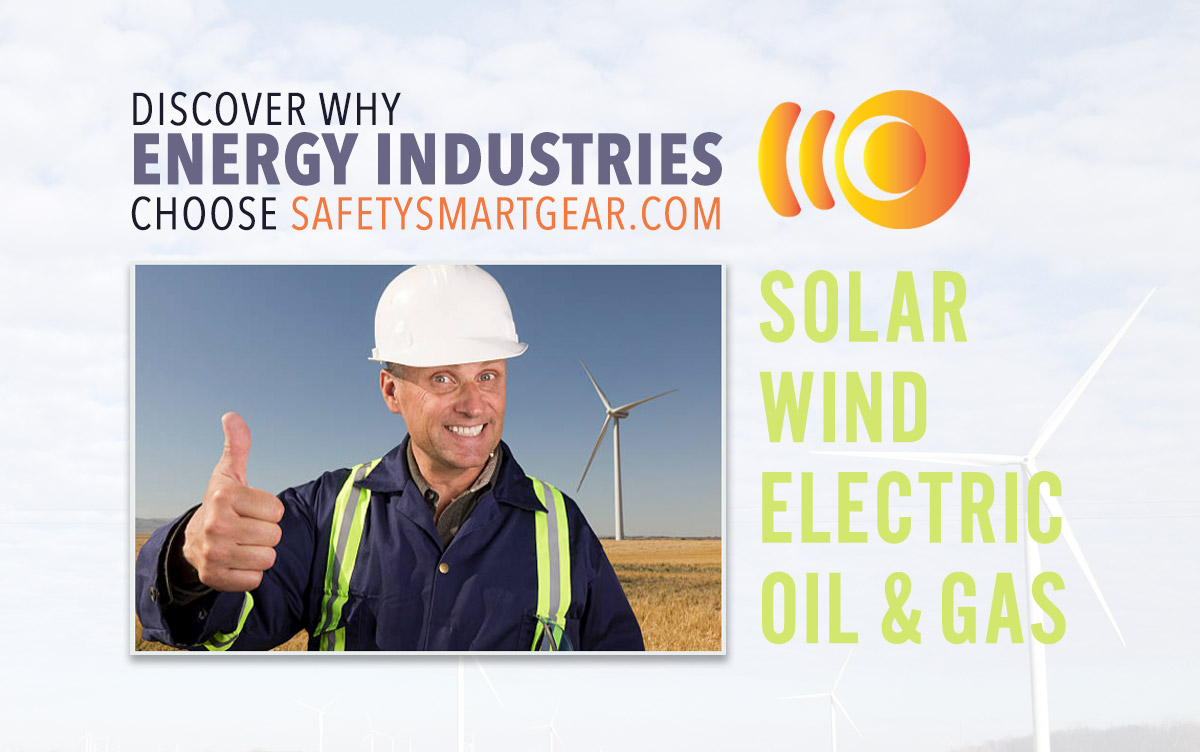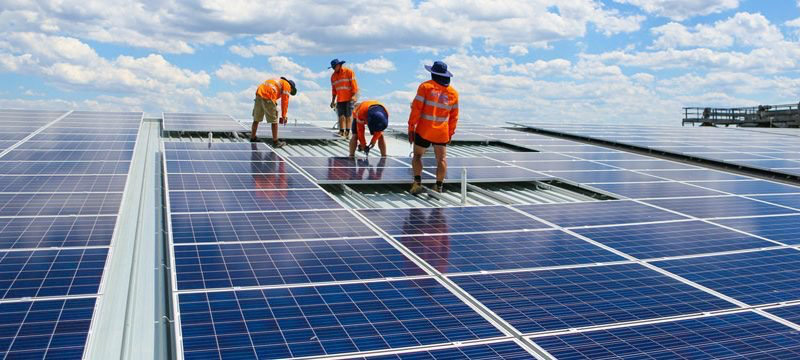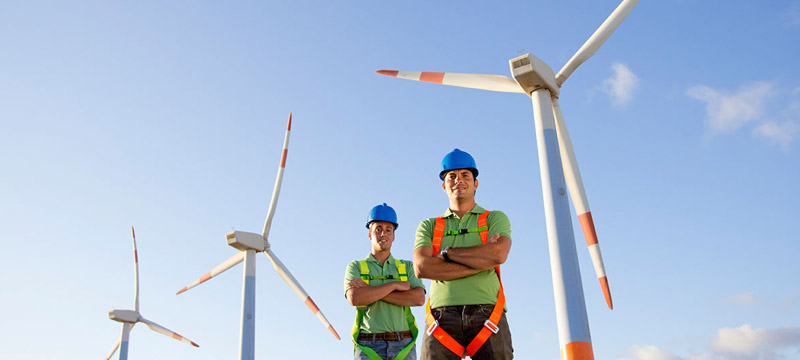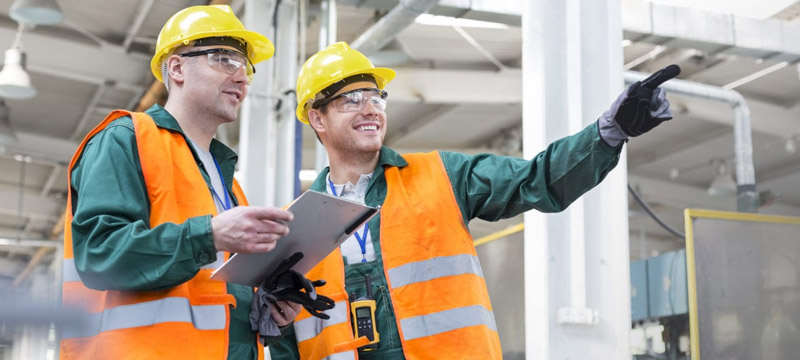Energy Industry & Safety Apparel

Discover Why Workers in the Energy Industries Choose SafetySmartGear.com for Safety Apparel and PPE (Personal Protective Equipment)
Choose Your Energy Industry: Solar - Wind - Electric - Oil & Gas
Solar Energy Industry

Workers in the solar energy industry are potentially exposed to a variety of serious hazards, such as arc flashes (which include arc flash burn and blast hazards), electric shock, falls, and thermal burn hazards that can cause injury and death. Solar energy employers (connecting to grid) are covered by the Electric power generation, transmission, and distribution standards and therefore may be required to implement the safe work practices and worker training requirements of OSHA's Electric Power Generation, Transmission and Distribution Standard, 29 CFR 1910.269. While solar energy is a growing industry, the hazards are not unique and OSHA has many standards that cover them. This page provides information about some hazards that workers in the solar industry may face.
- Falls
- Lockout/Tagout
- Crane and Hoist Safety
- Electrical
- Heat/Cold Stress
- Personal Protective Equipment
Personal Protective Equipment
Personal Protective Equipment is an essential part of every solar installation. It’s the employer’s job to assess the workplace for hazards and provide the PPE deemed necessary for the employee’s safety. Hard hats, gloves and steel-toed shoes with rubber soles are among the commonly required PPE for solar projects.
Employees are in turn responsible for using PPE in accordance with their employer’s instructions, maintaining it in a safe and reliable condition and requesting replacements when necessary.
Risk is part of running any business, but when it comes to an employee’s safety and health, risk should be avoided at all cost. Proactive safety planning and its successful implementation on the job can help ensure that accidents don’t happen.
Find Safety Clothing and Gear for Solar Energy Industry Workers: Hi Vis - Heat Stress Relief and PPE
Resource: https://www.osha.gov/dep/greenjobs/solar.html
Resource: https://www.thehartford.com/resources/energy/solar-energy-risks
Wind Energy Industry

Green Job Hazards: Wind Energy
Wind turbines generate electricity from wind, and are being manufactured and installed all across the nation. Wind energy employers need to protect their workers from workplace hazards and workers should be engaged in workplace safety and health and need to understand how to protect themselves from these hazards.
While this is a growing industry, the hazards are not unique and OSHA has many standards that cover them. This page provides information about some of the hazards that workers in the wind energy industry may face.
Fatalities/Incidents
Wind Energy workers are exposed to hazards that can result in fatalities and serious injuries. Many incidents involving falls, severe burns from electrical shocks and arc flashes/fires, and crushing injuries have been reported to OSHA. Some examples are given below:
- On a 33-year-old male lineman was shocked as he grasped a trailer ramp attached to a low boy trailer containing an excavator. The excavator was being operated in anticipation of being off-loaded from the trailer. The trailer was parked on a rural aggregate road adjacent to an access road for a wind turbine generator. The excavator operator rotated the upper works of the machine prior to moving the machine from the trailer. During the rotation the boom contacted a 7,200 volt primary rural power line. The power line was approximately 12 feet from the road with the trailer parked approximately two feet from the road edge. The injured worker had entry wounds in his hands and exit wounds in his feet. He was transported by EMS, treated and admitted for observation at a local hospital. He was discharged approximately 24 hours later and returned to work the following day.
- A victim was working in the bottom power cabinet of a wind turbine. He was checking the electrical connections and came into contact with a bus bar and arc flash erupted, causing injury to the victim. Afterward the victim was taken to a hospital by their technician and was met by the ambulance on the way. After arriving at the hospital he was later transferred by med-vac to another hospital in Oklahoma City and was treated for injuries. The company was notified by a representative of the hospital that the victim was deceased.
- A worker #1 and two coworkers were removing and replacing a broken bolt in the nacelle assembly of a wind turbine tower that was approximately 200 feet above the ground. They were heating the bolt with an oxygen-acetylene torch when a fire started. Worker #1 retreated to the rear of the nacelle, away from the ladder access area. While the two coworkers were able to descend the tower, Worker #1 fell approximately 200 feet to the ground, struck an electrical transformer box, and was killed.
- A worker attempted to descend an 80 ft. ladder that accessed a wind turbine generator. The worker slipped or fell from the ladder and was killed. The victim was wearing his company-furnished safety belt, but the safety lanyards were not attached. Both lanyards were later discovered attached to their tie-off connection at the top of the turbine generator.
- A site foreman was replacing a 480-volt circuit breaker serving a wind turbine. He turned a rotary switch to what he thought was the open position in order to isolate the circuit breaker. However, the worker did not test the circuit to ensure that it was deenergized. The worker had placed the rotary switch in a closed position, and the circuit breaker remained energized by back feed from a transformer. Using two plastic-handled screwdrivers, the employee shorted two contacts on the breaker to discharge static voltage buildup. This caused a fault, and the resultant electric arc caused deep flash burns to the worker's face and arms and ignited his shirt. The worker was hospitalized in a burn unit for 4 days.
Find Safety Clothing and Gear for Wind Energy Industry Workers: Hi Vis - Fall Protection and PPE
Resource: https://www.energy.gov/eere/wind/wind-energy-technologies-office
Electrical Energy Industry

Working with electricity can be dangerous. Engineers, electricians, and other professionals work with electricity directly, including working on overhead lines, cable harnesses, and circuit assemblies. Others, such as office workers and sales people, work with electricity indirectly and may also be exposed to electrical hazards.
Electricity has long been recognized as a serious workplace hazard. OSHA's electrical standards are designed to protect employees exposed to dangers such as electric shock, electrocution, fires, and explosions.
Good electrical safety habits can help protect you and your co-workers from injury. And you can play a role in recognizing and preventing workplace hazards. Keep in mind that:
- Electrocution is one of the top five causes of workplace deaths.
- Workers younger than 25 have the highest rate of death from electrical shock.
- Many workplace electrocutions involve touching a power line with long or tall equipment.
Personal Protective Equipment (PPE) is your first line of defense against shock and electrical burns. Keep boots, gloves and other gear in good condition - even a pinhole will let electricity through. Wear non-conductive protection on your head, face, hands and feet. Use insulated tools or handling equipment, such as non-conductive ropes and protective shields.
Find Safety Clothing and Gear for Electric Energy Industry Workers: Safety Vests - FR and Arc Flash Clothing and PPE
Resource: https://www.osha.gov/SLTC/electrical/
Oil and Gas Energy Industry

The oil and gas industry, potentially one of the most hazardous industry sectors in the United States, has one of the most thorough safety programs. The combination of powerful equipment, flammable chemicals and processes that are under high pressure can lead to hazardous and even deadly incidents. That’s why it’s essential for safety managers and supervisors to identify and communicate recommended safety controls and hazards that exist on each work site before work begins.
Safety Hazards Associated with Oil and Gas Extraction Activities
Oil and gas well drilling and servicing activities involve many different types of equipment and materials. Recognizing and controlling hazards is critical to preventing injuries and deaths. Several of these hazards are highlighted below.
- Vehicle Collisions
- Struck-By/ Caught-In/ Caught-Between
- Explosions and Fires
- Falls
- Confined Spaces
- Ergonomic Hazards
- High Pressure Lines and Equipment
- Electrical and Other Hazardous Energy
- Machine Hazards
- Planning and Prevention
Workers in the oil and gas industries face the risk of fire and explosion due to ignition of flammable vapors or gases. Flammable gases, such as well gases, vapors, and hydrogen sulfide, can be released from wells, trucks, production equipment or surface equipment such as tanks and shale shakers. Ignition sources can include static, electrical energy sources, open flames, lightning, cigarettes, cutting and welding tools, hot surfaces, and frictional heat.
How to Protect Workers in the Oil & Gas Industry
These flame-resistant clothing tips will help keep your employees safe in dangerous work environments.
Why FR Clothing Matters
When burn injuries do occur, the consequences can be severe. In addition to the tragedy of serious injury or death, burn injuries can cost a company millions of dollars in OSHA fines, hospital fees, legal costs, increased insurance premiums, reputation damage and lost productivity. According to the American Burn Association, a survivor with 40-60% body burn has an average hospital stay of 54 days, with costs averaging $780,000. With more severe injuries, the costs can be even higher.
For those in the oil and gas industry, burn injuries are a serious concern. Just last year, three oilfield workers in Colorado were performing routine maintenance when a pipeline fire broke out, injuring all three workers. One of the men passed away five days later.
Unfortunately, the Colorado pipeline fire is far from an isolated incident. Oil and gas work is, by nature, dangerous, and while efforts are constantly being made to reduce risks, fires and explosions still present a significant hazard.
Why FR Clothing Matters
When burn injuries do occur, the consequences can be severe. In addition to the tragedy of serious injury or death, burn injuries can cost a company millions of dollars in OSHA fines, hospital fees, legal costs, increased insurance premiums, reputation damage and lost productivity. According to the American Burn Association, a survivor with 40-60% body burn has an average hospital stay of 54 days, with costs averaging $780,000. With more severe injuries, the costs can be even higher.
And that’s just the hospital fees. In May 2016, a 38-year-old pipefitter working at a South Dakota refinery suffered fatal burn injuries when ethanol spilled from a process pipe he was working on and was ignited by flames from nearby welding operations. Both the refinery and the pipefitter’s employer were fined by OSHA. Failure to provide the proper protective clothing was among the citations, and the combined OSHA fines amounted to nearly $100,000.
Preventing fires and explosions from occurring is always better than trying to mitigate the damage afterward, and the first step toward avoiding burn injuries should always be to follow safe work practices. However, even when the proper precautions are taken, it is still important to be prepared in the event that an accident does happen. That means always wearing the proper flame-resistant (FR) clothing on the job.
Identifying the Proper FR Protection
The first consideration when selecting FR clothing should always be safety. OSHA 1910.132 requires employers to identify risks and protect employees from hazards in the workplace. This includes ensuring each employee has the proper personal protective equipment (PPE). On more than one occasion, OSHA has used this regulation as a basis for citations when employees have suffered burn injuries and the employer did not require FR protective apparel. To comply with OSHA regulations and help keep employees from harm, it is important to identify the types of hazards workers might encounter on the job and ensure that the FR clothing you choose is designed to address those hazards.
Once you’ve identified the hazards present in your work environment, consult the applicable safety standards, such as NFPA 2112 and 2113 for flash-fire hazards and NFPA 70E for arc-flash hazards. For certain work environments, additional safety standards may apply, such as the ANSI/ISEA 107-2015 American National Standard for High-Visibility Safety Apparel, which discusses the protection necessary for workers in environments with poor visibility. Choosing FR clothing that meets the requirements of all the relevant standards will give employees the best possible protection against the hazards they are most likely to face.
FR Clothing Considerations
In addition to protection, comfort is another important consideration when selecting FR workwear. If workers are uncomfortable in their FR clothing, they may not wear it consistently or correctly, which can detract from the safety benefits. For example, if workers are too hot, they may be tempted to roll up their sleeves or unbutton their shirts, leaving areas of the skin exposed and vulnerable to burn injuries.
For the greatest possible comfort, it is important to provide correctly sized garments for each worker. This may mean ordering non-stock sizes or seeking garments designed specifically for women. Additionally, you’ll want to choose garments that allow for the greatest possible ease of movement—such as coveralls that feature action backs—to enhance comfort and support job performance. It is also helpful to select products that are appropriate for temperature and weather conditions. This means identifying fabric types that balance proper protection with comfort considerations such as weight, warmth, breathability and moisture wicking.
It is also important to keep in mind that FR clothing comfort is often subjective, and it may be beneficial to work with an FR clothing manufacturer that can help you conduct a wear trial prior to making your final purchase. Through a wear trial, employees are able to sample various workwear options firsthand and provide feedback. By selecting FR clothing that fits correctly, provides full mobility, prevents workers from becoming too hot or too cold, and meets employees’ subjective preferences, you can increase the chances that it will be worn consistently and properly.
Finally, beyond protection and comfort, you’ll also want to consider the durability and long-term value of FR clothing. While certain lower-quality options may be less expensive initially, they may need to be replaced more frequently due to excess shrinkage or poor durability, resulting in higher overall costs in the long run. Also, keep in mind that FR clothing that has holes, rips or worn-out areas may not offer adequate protection, compromising the wearer’s safety. To maximize protection while achieving the best possible value, select FR clothing that is made from high-quality fabrics and built with durability in mind. Choose products that are made by trusted manufacturers, and look for features such as reinforced snaps, multiple bartacks in high-stress areas, reinforced pockets, double- and triple-stitched seams, and high stitch counts for added durability.
In the oil and gas industry, burn injuries can have devastating consequences. But by following safe work practices and implementing an effective FR clothing program, you can significantly reduce the likelihood that a serious injury will occur.
Find Safety Clothing and Gear for Oil and Gas Energy Industry Workers: FR and Arc Flash Clothing and PPE
Mark Saner is FR technical manager with Workrite Uniform Company. He has 40 years of experience in the fire and safety industries, including 29 years in technical support, safety standards and product development for Akron Brass Manufacturing Company. He participates as a voting member within a number of national and international safety organizations to help develop, revise, influence and further improve standards for worker safety.
Resource: https://www.osha.gov/SLTC/oilgaswelldrilling/safetyhazards.html
Resource: https://www.ehstoday.com/safety/safety-practices-oil-and-gas-industry-infographic
Resource: https://www.ehstoday.com/protective-clothing/dress-stress-how-protect-workers-oil-gas-industry
